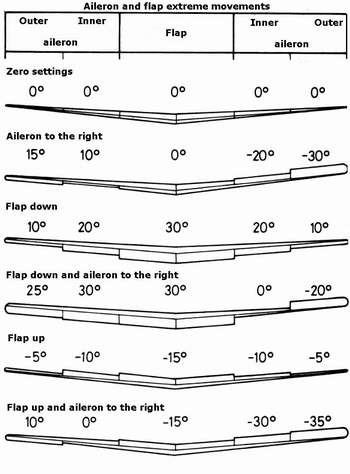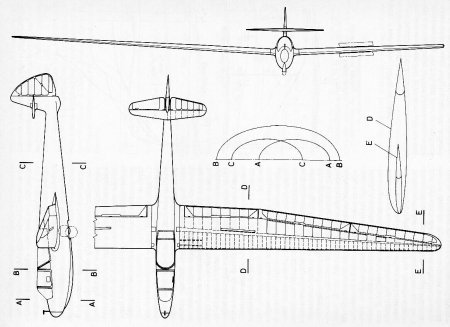HUNGARIAN
GLIDERS
1933-2000
| Type designation: |
M-30 |
| Name: |
Fergeteg |
| Designer: |
Lajos BENICZKY |
| Class: |
High performance |
| General arrangement: |
Shoulder wing, tandem seats, retractable wheel, traditional tail unit |
| Crew: |
2 |
| First flight: |
August 1950 |
| Manufacturer: |
Sirály Aircraft Ltd., Central Workshop of Hungarian Aeronautical Association |
| Number of built: |
1 |
.jpg)
Short history:
In the beginning of the '40s gliding in Hungary had reached the level where the demand on training of high performance gliding widened. It was decided by the MSrE (Aeroclub of the Technical University) to design and build a two-seater performance glider which would be suitable for performance gliding and aerobatics instruction as well. Another aim was to create a glider, which is capable of to break existing records. The designer, Lajos Beniczky and his team had started to design the new glider in 1942 and the work continued up to the fall of 1944. The construction work had also been started at the workshop of MSrE. The glider got the type designation of M-30, Fergeteg. Unfortunately the nearly completed glider had been destroyed during the siege of Budapest, and Beniczky died in 1945 as well.
After the war, in 1948, the idea to build the Fergeteg rebirthed at the OMRE (Hungarian National Flying Association). A design bureau was established within OMRE on Béla Samu's and Hugó Nagy's initiative to redesign the glider utilizing the remaining documentation as well as to develop other new gliders. The basic conception of the design remained unchanged, however details were modified. The construction had been started by the Sirály Aircraft Ltd. and was completed by the Central Workshop of the Hungarian Aeronautical Association at Budaörs. The glider first flew in August 1950.
The first flights had indicated very good performance, however problems were also manifested. The new version was heavier of 100 kg then the original version. The height of back seat had been too low and the contour of the canopy was modified after the first flights. However the result of this modification was a vibration on the horizonzal stabilizer at all speeds. The excessive forces on the ailerons indicated another problem. To solve these problems certain elements were modified and the glider flew again in 1951.
Based on these experiences and a study accomplished by the Aircraft Department of the Technical University the glider was again redesigned and no other examples were built of this version.
Structure: All wooden
Wing:
The wing had one main spar, and a short fore and an aft secondary spar. The wing was covered in front of the main spar by plywood creating a strong torsional box structure. The wing was covered spanwise by plywood behind the main spar up to the outer end of the airbrakes, beyond that by fabric. The planform of the wing was double-trapezoid with the leading edge perpendicular to the fuselage main axis. The split ailerons were differential and were connected to the flaps. When the flaps were moved the zero settings of the ailerons moved accordingly. The movement of the ailerons and flaps is shown on the drawing. The ailerons were activated by a push-rod type mechanism.
 Göppingen type airbrakes were fitted. The wing had a slight negative sweep to secure good visibility. The half wings were not directly connected, but to a strong steel tube structure passing through the fuselage and to which the fuselage was attached by lighter fittings. The connection was made by one vertical bolt on each side.
Göppingen type airbrakes were fitted. The wing had a slight negative sweep to secure good visibility. The half wings were not directly connected, but to a strong steel tube structure passing through the fuselage and to which the fuselage was attached by lighter fittings. The connection was made by one vertical bolt on each side.
Fuselage:
The soulder-wing glider had a tandem seat arrangement. The elliptical cross section fuselage was a plywood covered semi-monocoque structure. At the range of the seats the side of the fuselage was strengthened by double plywood covering. The fore and aft part of the canopy could be separately lifted off. The landing gear consisted of a rubber-ring suspended nose skid, a retractable wheel and an aft skid, which was a strengthened part of the fuselage keel. Both pilot's seats were fitted with an instrument panel.
Tail unit:
The tail unit had a traditional arrangement, with the elevator located above the fuselage on the vertical stabilizer. The elevator was of a semi-balanced type. The horizontal stabilizer's movement was half of the movement of the elevator. The elevator was activated by a push-rod type mechanism.
.jpg)

| Dimensions: |
| Wing: |
| Span, m: |
18 |
| Area, m2: |
18,96 |
| Aspect ratio: |
17,1 |
| Chord (root), m: |
1,376 |
| Chord (tip), m: |
0,52 |
| Airfoil (root), m: |
NACA 23 012 |
| Airfoil (tip), m: |
NACA 0009 |
| Dihedral, degree: |
3 |
| Sweep, degree: |
Midwing: -0,23; outer part: -1,9 |
| Washout: |
Aerodynamic |
| Aileron: |
| Span, m: |
6 |
| Mean chord, m: |
0,24 |
| Total area, m2: |
? |
| Balancing: |
None |
| Flap: |
| Type: |
Plain |
| Area, m2: |
? |
| Relative length, %: |
? |
| Movement (+/-), degree: |
+30/-15 |
| Airbrakes: |
| Type: |
Göppingen |
| Position (upside/downside): |
u/d |
| Total area, m2: |
? |
| Position, % of chord: |
cca 45 |
| Horizontal stabilizer: |
| Span, m: |
2,53 |
| Area, m2: |
? |
| Elevator: |
| Span, m: |
2,53 |
| Area, m2: |
? |
| Airfoil: |
? |
| Balancing: |
Semi-balance elevator |
| Trim: |
No |
| Vertical stabilizer and rudder: |
| Total area, m2: |
? |
| Rudder area, m2: |
? |
| Balancing: |
None |
| Fuselage: |
| Length, m: |
7,9 |
| Width, m: |
cca. 0,6 |
| Height: |
? |
| Cross section, m2: |
? |
| Landing gear: |
| Type: |
retractable |
| Wheel diameter, m: |
? |
| Masses: |
| Wing, kg: |
? |
| Fuselage, kg: |
? |
| Tail unit, kg: |
? |
| Empty glider, kg: |
360 |
| Gross, kg: |
caa. 530 |
| Ballast, kg: |
None |
| Wing loading, kg/m2: |
cca. 28 |
| Speeds: |
| VNE, km/h: |
? |
| Max. speed with open airbrakes, km/h: |
? |
| Max. aerotow speed, km/h: |
? |
| Max. speed in rough air, km/h: |
? |
| Stall speed, km/h: |
60; with flap down 45 (original version, calculated) |
| Performance: |
| Min. sink, m/s (at gliding speed, km/h): |
0,7/? |
| Best L/D (at gliding speed, km/h): |
33/90 |
| Start methods: |
Aerotow |

Origin of data and 3-view drawing:
Jereb Gábor: Magyar vitorlázó repülőgépek, Műszaki Könyvkiadó, 1988, Budapest
(Gábor JEREB: Hungarian Gliders, Technical Publishing House, 1988, Budapest)
Gábor FEKECS E-mail: fekecs.gabor@t-online.hu
 Göppingen type airbrakes were fitted. The wing had a slight negative sweep to secure good visibility. The half wings were not directly connected, but to a strong steel tube structure passing through the fuselage and to which the fuselage was attached by lighter fittings. The connection was made by one vertical bolt on each side.
Göppingen type airbrakes were fitted. The wing had a slight negative sweep to secure good visibility. The half wings were not directly connected, but to a strong steel tube structure passing through the fuselage and to which the fuselage was attached by lighter fittings. The connection was made by one vertical bolt on each side..jpg)
.jpg)
